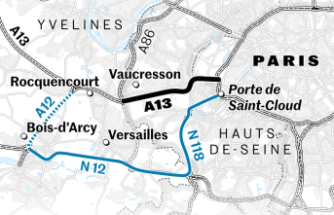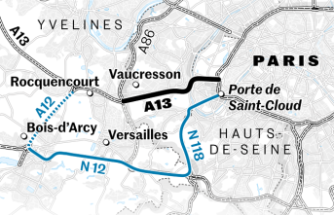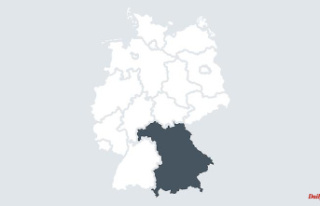Fewer and fewer diesels are being sold in Germany. Nevertheless, manufacturers like Kia also have them in their range. So also in the fifth edition of the Sportage. It has been further developed together with the engine in such a way that it is based not only on the technology but also on the price of the premium manufacturers. The ntv.de practical test should find out whether this is justified.
The fact that Kia is offering the Sportage in the fifth model generation for the first time in a version specially designed for the European market is shown by two things: First, that it has reached a price level that is a hair's breadth below that of the premium suppliers and secondly, because Kia is offering the Sorento as a 1.6 CRDi, i.e. as a diesel. However, it feels like this happens a little underhand, because the self-igniter is no longer really suffered and up-to-date.
Is not he? Well, Kia has coupled the 1.6-liter diesel - like the premium competition from Stuttgart and Munich, for example - to a 48-volt electrical system including a lithium-ion battery. This includes a 12 kW starter generator and a DC/DC converter for exchanging energy between the two on-board networks. As with Mercedes and BMW, the starter generator is connected to the crankshaft by a belt drive and can support the drive as an electric motor or charge the battery as a generator. When high power is required, it makes additional torque available, while when accelerating slightly, it relieves the combustion engine of its work, thereby reducing its engine load and fuel consumption.
Incidentally, Kia announces that the 1.6 CRDi with front-wheel drive and manual switch is the most economical Sportage ever in its in-house test. The propellant is said to have needed just 4.2 liters over 100 kilometers. This cannot be fully confirmed in the ntv.de test with the all-wheel drive variant and the buttery-smooth dual-clutch transmission. But here, too, the diesel is quite frugal. This is supported by the coasting function, which always switches off the engine in Eco driving mode when you take your foot off the gas. Nevertheless, the ntv.de test over a good 1000 kilometers only ended with an average consumption of 6.3 liters.
This is a decent value, which is very close to the WLTP value of 5.8 liters determined by Kia for the test car. But this is also due to the fact that the four-cylinder turbo diesel with its 136 hp is anything but a racing machine even in Sport mode and hardly causes the driver to be overly dynamic with the Sportage. The maximum torque of 320 Newton meters pushes well over all four wheels when required, but then does not allow the 1.7 ton Korean to sprint faster than 11.6 seconds from a standstill to 100 km/h. And the specified maximum speed of 180 can be driven, but - and this is promised - there will be no endurance run at this speed.
So you're more cautious with the diesel and you're happy about the electronic damper control installed as standard in the GT-Line, which reacts to steering movements as well as to those of the body. This prevents diving, pitching and rolling movements, without which the Sportage can then sweep around the corner really dynamically. If it then goes comfortably straight ahead again, the Sportage driver can enjoy the interior. In fact, the Koreans tried to use fine materials here and there was nothing to complain about in the test car. Only the air vents on the dashboard and center console, which are framed in black piano lacquer, proved, as so often, to be dust collectors and fingerprint collectors.
A highlight of the Sportage is the fully digital cockpit, which stretches well past the middle of the dashboard. A 31.2 centimeter display in front of the driver reports the driving data, to the right of which the multimedia system or navigation is operated via a touchscreen of the same size. Of course, this can also be replaced via Android Auto or Apple CarPlay. However, this only works via a conventional USB connection. The mini-USB is only intended for charging personal hardware. Unfortunately, wireless communication via Bluetooth, as known from vehicles from the VW Group, does not exist. There is a so-called multimedia control unit below the touchscreen with two rotary controls and a row of double-assigned sensor buttons that allow direct access to the most important infotainment and climate control functions without having to delve deep into the menu.
What's also in the 4.52 meter long Sportage is enough space for all occupants. Unfortunately, the same cannot be said about the storage options for everyday odds and ends such as glasses or a water bottle. There is no reasonable storage space for the first-mentioned utensil and the thirst-quenchers, even in smaller formats, can hardly be placed in the very narrow inside door pockets. It is also amazing that the boot of the diesel is the smallest compared to the petrol and plug-in hybrid with 526 liters of storage space. It can be equipped with an electrically opening tailgate. It already floats upwards when the key holder places itself behind it. Anyone who throws the rear seat backs over by remote unlocking has 1715 liters available in the diesel.
That's almost as lavish as the range of assistance systems for the Sportage. Of course, this also includes the lane departure warning system, which wakes up every time you start the car, but which can be deactivated quickly in city traffic or on country roads by pressing and holding the button on the steering wheel. Not so easy to deactivate is the somewhat overly nervous distance cruise control, which recognizes tricky situations more often than they are actually there. But the traffic jam assistant does a really good job and the head-up display also pleases with a high resolution and an eye-friendly size.
In the end, however, everything has its price, a premium price, one might almost say. Because with the GT-Line equipment, the 1.6 CRDi 48V AWD DCT already costs 47,090 euros. Anyone who now chooses the sound system, which is only available with an extensive armada of assistance systems, will end up with a final price of 49,690 euros. Just for comparison: A BMW X1 with 150 hp diesel unit in the Sport Line equipment line costs 44,400 euros and comes fully equipped to 50,980 euros. Seen in this light, people are now shopping at Kia in the premium segment.
Conclusion: The Kia Sportage 1.6 CRDi 48V AWD DCT is a real cross-country skier. With its 54-liter tank, up to 800 kilometers can be covered, which speaks for its frugality. The Koreans developed for Europe don't have to hide when it comes to processing and technical accessories either. But whether that justifies the price, which is in the premium segment, is something that the prospective buyer should best decide during a test drive.












